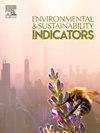A feasibility study of combining solar/wind energy to power a water pumping system in Jordan's Desert/Al-Mudawwara village
IF 5.4
Q1 ENVIRONMENTAL SCIENCES
引用次数: 0
Abstract
Water availability and accessibility are the most significant challenges facing developing countries like Jordan, which is ranked as one of the world's worst countries in terms of water resources. In Jordan's isolated desert areas, where underground wells supply water for livestock and human consumption, water pumping systems (WPSs) are essential. Therefore, finding alternative energy sources is necessary to power underground WPSs. However, numerous diesel generator (DG) issues impact the energy supply. This article presents the design and evaluation of a hybrid renewable energy system (HRES) powering a WPS in an isolated desert region (Al-Mudawwara village/Ma'an governorate) with a daily demand of 40.71 kWh, which is economically viable, environmentally friendly, and sustainable. Using the HOMER simulation software, the most efficient scenario is determined considering the average monthly solar radiation, average wind speed of 3.79 kWh/m2 and 6.31 m/s, respectively, economic limitations, and the component's technical specifications. The net-present cost (NPC), cost of energy (CoE), and the percentage of renewable energy fraction (REF) and Greenhouse gas emissions (GHGE) are utilized as optimization criteria. The results obtained show that the scenario with minimum initial capital cost (ICC) and total NPC, respectively, was the one with DG/WT/storage batteries (SB) ($US 53,69) and ($US 59,611). The HRES (PV/WT/SBs) is the optimal scenario since it produces power at the lowest CoE ($US 0.241/kWh), leading to reliable energy and eliminating GHGE.
求助全文
约1分钟内获得全文
求助全文
来源期刊

Environmental and Sustainability Indicators
Environmental Science-Environmental Science (miscellaneous)
CiteScore
7.80
自引率
2.30%
发文量
49
审稿时长
57 days
 求助内容:
求助内容: 应助结果提醒方式:
应助结果提醒方式:


